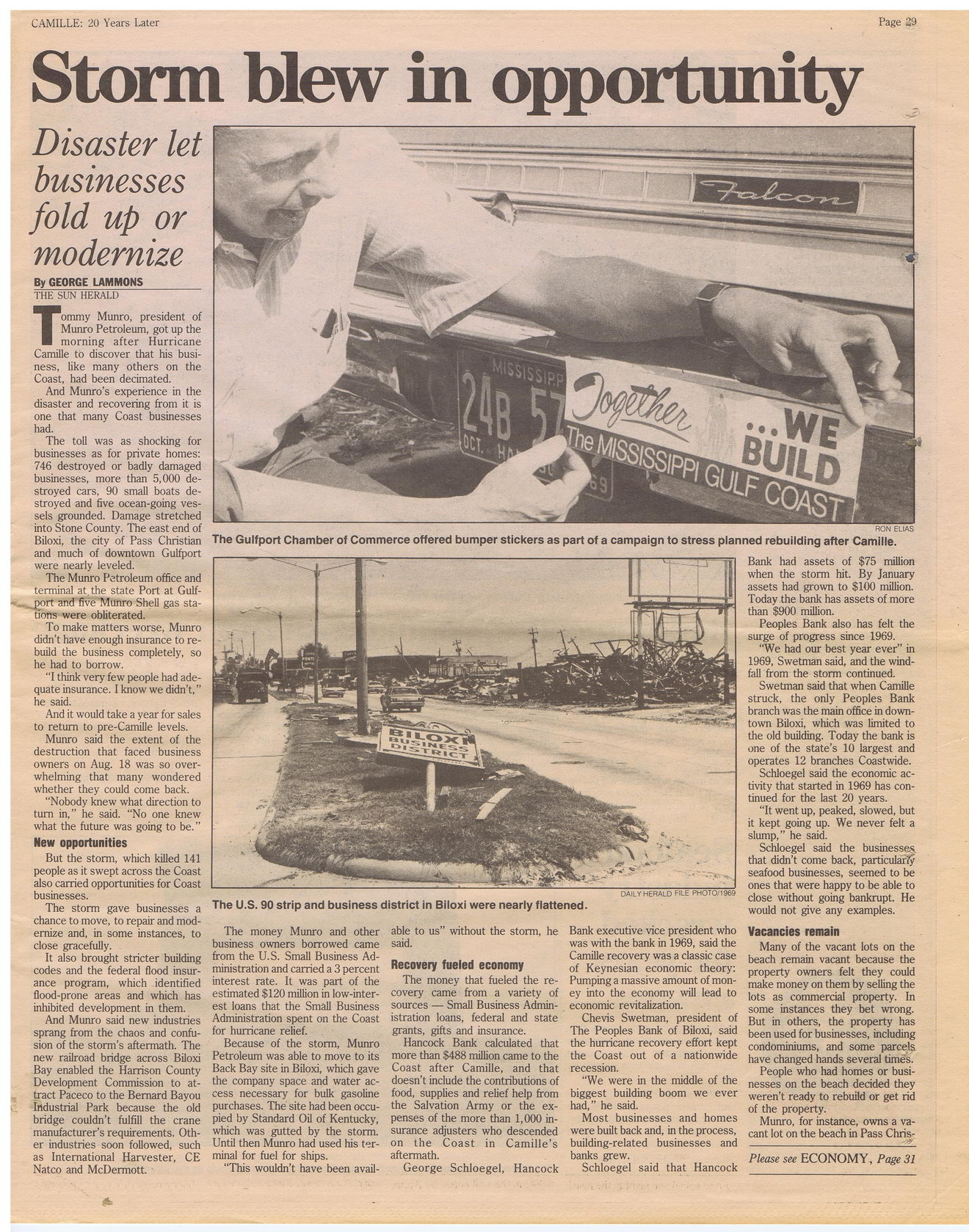This text was obtained via automated optical character recognition.
It has not been edited and may therefore contain several errors.
CAMILLE: 20 Years Later Page 29 Storm blew in opportunity RON ELIAS The Gulfport Chamber of Commerce offered bumper siictcers as part of a campaign to stress planned rebuilding after Camille. DAILY HERALD FILE PHOTO/1969 The U.S. 90 strip and business district in Biloxi were nearly flattened. Disaster let businesses fold up or modernize By GEORGE LAMMONS THE SUN HERALD Tommy Munro, president of Munro Petroleum, got up the morning after Hurricane Camille to discover that his business, like many others on the Coast, had been decimated. And Munro’s experience in the disaster and recovering from it is one that many Coast businesses had. The toll was as shocking for businesses as for private homes: 746 destroyed or badly damaged businesses, more than 5,000 destroyed cars, 90 small boats destroyed and five ocean-going vessels grounded. Damage stretched into Stone County. The east end of Biloxi, the city of Pass Christian and much of downtown Gulfport were nearly leveled. The Munro Petroleum office and terminal at. the state Port at Gulfport and five Munro Shell gas stations were obliterated. To make matters worse, Munro didn’t have enough insurance to rebuild the business completely, so he had to borrow. “I think very few people had adequate insurance. I know we didn’t, ” he said. And it would take a year for sales to return to pre-Camille levels. Munro said the extent of the destruction that faced business owners on Aug. 18 was so overwhelming that many wondered whether they could come back. “Nobody knew what direction to turn in,” he said. “No one knew what the future was going to be. ” New opportunities But the storm, which killed 141 people as it swept across the Coast also carried opportunities for Coast businesses. The storm gave businesses a chance to move, to repair and modernize and, in some instances, to close gracefully. It also brought stricter building codes and the federal flood insurance program, which identified flood-prone areas and which has inhibited development in them. And Munro said new industries sprang from the chaos and confusion of the storm’s aftermath. The new railroad bridge across Biloxi Bay enabled the Harrison County Development Commission to attract Paceco to the Bernard Bayou Industrial Park because the old bridge couldn’t fulfill the crane manufacturer’s requirements. Other industries soon followed, such as International Harvester, CE Natco and McDermott. The money Munro and other business owners borrowed came from the U.S. Small Business Administration and carried a 3 percent interest rate. It was part of the estimated $120 million in low-inter-est loans that the Small Business Administration spent on the Coast for hurricane relief. Because of the storm, Munro Petroleum was able to move to its Back Bay site in Biloxi, which gave the company space and water access necessary for bulk gasoline purchases. The site had been occupied by Standard Oil of Kentucky, which was gutted by the storm. Until then Munro had used his terminal for fuel for ships. “This wouldn’t have been avail- able to us” without the storm, he said. Recovery fueled economy The money that fueled the recovery came from a variety of sources — Small Business Administration loans, federal and state grants, gifts and insurance. Hancock Bank calculated that more than $488 million came to the Coast after Camille, and that doesn’t include the contributions of food, supplies and relief help from the Salvation Army or the expenses of the more than 1,000 insurance adjusters who descended on the Coast in Camille’s aftermath. George Schloegel, Hancock Bank executive vice president who was with the bank in 1969, said the Camille recovery was a classic case of Keynesian economic theory: Pumping a massive amount of money into the economy will lead to economic revitalization. Chevis Swetman, president of The Peoples Bank of Biloxi, said the hurricane recovery effort kept the Coast out of a nationwide recession. “We were in the middle of the biggest building boom we ever had,” he said. Most businesses and homes were built back and, in the process, building-related businesses and banks grew. Schloegel said that Hancock when the storm hit. By January assets had grown to $100 million. Today the bank has assets of more than $900 million. Peoples Bank also has felt the surge of progress since 1969. “We had our best year ever” in 1969, Swetman said, and the windfall from the storm continued. Swetman said that when Camille struck, the only Peoples Bank branch was the main office in downtown Biloxi, which was limited to the old building. Today the bank is one of the state’s 10 largest and operates 12 branches Coastwide. Schloegel said the economic activity that started in 1969 has continued for the last 20 years. “It went up, peaked, slowed, but it kept going up. We never felt a slump,” he said. Schloegel said the businesses that didn’t come back, particular^ seafood businesses, seemed to be ones that were happy to be able to close without going bankrupt. He would not give any examples. Vacancies remain Many of the vacant lots on the beach remain vacant because the property owners felt they could make money on them by selling the lots as commercial property. In some instances they bet wrong. But in others, the property has been used for businesses, including condominiums, and some parcels have changed hands several times. People who had homes or businesses on the beach decided they weren’t ready to rebuild or get rid of the property. Munro, for instance, owns a vacant lot on the beach in Pass Chris- ________________________________ Please see ECONOMY, Page 31

Hurricane Camille Camille-20-Years-Later (30)